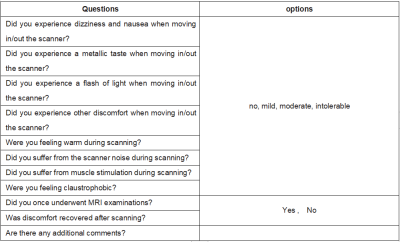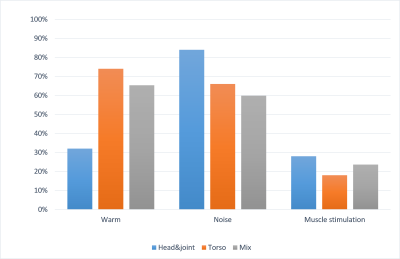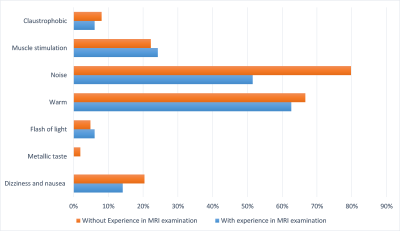2630
Study of Subjective Tolerance during 5T Whole-Body MRI Examinations1United Imaging Healthcare, Shanghai, China, 2Department of Radiology,Zhongnan Hospital of Wuhan University, Wuhan, China, 3Department of Radiology, Zhongshan Hospital, Fudan University, Shanghai, China, 4Shanghai Institute of Medical Imaging, Shanghai, China, 5UIH America, Inc., Houston, TX, United States
Synopsis
Questionnaires on subjective feeling were collected and analyzed from 202 subjects following whole-body MRI examinations at 5T. No intolerable discomfort was reported, indicating whole-body examinations at 5T is safe when necessary safety protocols were followed.
Introduction
High field Magnetic Resonance Imaging (MRI) has significant advantages such as increased signal-to-noise ratio (SNR), stronger susceptibility effects and improved spectral resolution. Rapid development of ultra-high-field (UHF) MRI has led to increased safety concerns including vertigo, peripheral nerve stimulation, acoustic noise and specific absorption rate (SAR). Several MR safety studies on human exposure to high magnetic fields focused on biological effects 1. However, body parts in those studies at fields equal to or above 7T were mostly limited to only head and joint2-4, unrepresentative of clinical scenario. In studies involving subjective feeling of body examinations in UHF MRI, results are ambiguous based on limited existing data.In this study, we analyzed the reported subjective experiences from subjects who underwent 5T whole-body MRI scans, using questionnaires. The reported feelings were counted and analyzed.
Methods
A total of 395 examinations were performed on 202 subjects, with the following population characteristics: 145 men, 57 women; mean age, 41.9 years (range 20-69 years); mean height, 168.7cm (range 152-185cm); mean weight 68.2kg (range, 44-110kg). Body parts examined included: head, 78; abdomen, 29; pelvis, 58; spine, 99; joint, 33; thorax & cardiac, 71; and lower extremity, 27.Scans were performed at two different site (1. Zhongshan Hospital, Fudan University, China;2. Zhongnan Hospital of Wuhan University, China) having the same 5T whole-body MRI system (uMR Jupiter, United Imaging Healthcare, China). The scanner features a 60 cm bore size, maximum gradient slew rate of 200 T/m/s and maximum gradient amplitude of 120 mT/m. Subjects were moved in and out of the bore on the patient table at the speed of 20 cm/s.
The study was approved by local Institution Review Board. Subjects were instructed to squeeze an alarm ball if there was need to stop the scan due to discomfort. After MRI scans the subjects were asked to fill a questionnaire (Table 1) following proper explanation by a researcher to ensure accurate understanding of the questions. All questions were answered on the following scales: no, mild, moderate or intolerable, except for the last three questions.
Results
All subjects successfully completed examinations. No intolerable discomfort was reported in the questionnaires. The three most frequently reported negative findings (answers mild and moderate) were, in descending order, noise (64.35%), feeling warm (63.6%) and muscle stimulation (22.8%). The physiological response in 5T MRI scan that are caused by static magnetic field, including dizziness (17.32%), metallic taste (1%), a flash of light (5.4%), were much less than those in 7T scan (~30%)3. See Figure 1 for details.According to different body parts scanned, subjects were classified into three categories: 25 subjects only underwent head & joint examinations; 50 subjects only underwent torso examinations; the others underwent both head & joint and torso examinations. Among the three categories, the most significant difference in physiological response was feeling warm: 32% (head & joint only examination), 74% (torso only examination) and 65.35% (both head & joint and torso examinations). There were also differences in noise and muscle stimulation among the categories: in noise, it’s 84% (head & joint only examination), 66% (torso only examination) and 59.84% (both head & joint and torso examinations), respectively. In muscle stimulation, it’s 28% (only head & joint examination), 18% (only torso examination) and 23.62% (both head & joint and torso examinations), respectively. Subjects with prior experience of MRI examinations had higher tolerance lever on acoustic noise. The results are summarized in Figures 2 & 3.
One subject didn’t recover from dizziness right after examination, but soon recovered after eating and drinking following medical staff’s advice.
Conclusion and Discussion
No intolerable discomfort was reported, indicating whole-body examinations at 5T is safe when necessary safety protocols were followed. Torso examinations caused more heating than head & joint examinations, consistent with SAR prediction values. The predicting and monitoring of SAR in torso examinations are of great importance at 5T. Occurrence of discomforts at 5T related to static magnetic field, such as dizziness, metallic taste and a flash of light, were less frequent than those in 7T and 9.4T.In the next few months, more examinations are warranted to better understand the relationship between the prediction value of SAR and the statistical questionnaire result of feeling warm.
Acknowledgements
This work is supported by National Key R&D Program of China N0.2017YFC0108800.References
[1] Hoff MN, McKinney A 4th, Shellock FG, Rassner U, Gilk T, Watson RE Jr, Greenberg TD, Froelich J, Kanal E. Safety Considerations of 7-T MRI in Clinical Practice. Radiology. 2019,292(3):509-518.
[2] Heilmaier C , Theysohn J M , Maderwald S , et al. A large-scale study on subjective perception of discomfort during 7 and 1.5T MRI examinations. Bioelectromagnetics, 2011, 32(8):610–619.
[3] Versluis M J , Teeuwisse W M , Kan H E , et al. Subject tolerance of 7 T MRI examinations. Journal of Magnetic Resonance Imaging, 2013, 38(3):722-725.
[4] Rauschenberg J, Nagel AM, Ladd SC, Theysohn JM, Ladd ME, Möller HE, Trampel R, Turner R, Pohmann R, Scheffler K, Brechmann A, Stadler J, Felder J, Shah NJ, Semmler W. Multicenter study of subjective acceptance during magnetic resonance imaging at 7 and 9.4 T. Invest Radiol. 2014,49(5):249-59.



